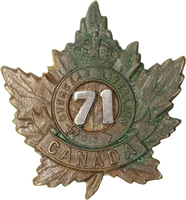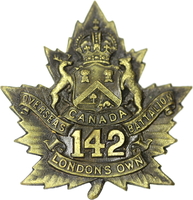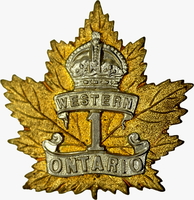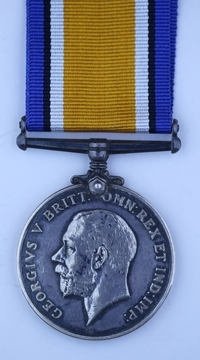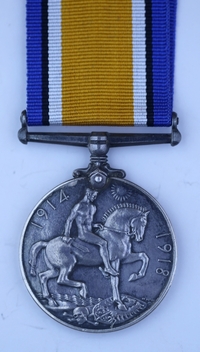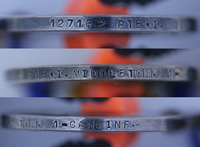
127261 Pte Isaac Allen Middleton
71st Canadian Overseas Battalion
70th Canadian Overseas Battalion
142nd Canadian Overseas Battalion
1st Canadian Infantry Battalion
By: Capt (ret'd) Michael M. O'Leary, CD, The RCR
Isaac Allen Middleton was born on 29 Jul 1878 at Granton, Middlesex County, Ontario. Middleton's parents William (1835-1900) and Sarah (1840-1925), née Minor, owned a hotel at Granton. Isaac was the eighth of nine children in the family. William Middleton died in 1900, leaving his wife to run the family's business.
Middleton attested for service in the Canadian Expeditionary Force (C.E.F.) with the 71st Overseas Battalion at London, Ont., on 12 Oct 1915. A 37-year-old painter, Middleton was described on his attestation paper as 5 feet 4 inches tall, weighing 125 pounds, with a 34-inch chest, a dark complexion, hazel eyes, and brown hair. His religious denomination was Church of England (Anglican). Middleton identified his mother, Mrs. Sarah Middleton, Granton, Ont., as his next of kin. On attesting with the 71st Battalion, Middleton was given the regimental number 127162.
The 71st Battalion, C.E.F., was mobilized at and recruited in Woodstock, Ont. Authorized on 15 Aug 1915, the battalion embarked for Great Britain on 1 Apr 1916 when it sailed aboard the S.S. Olympic. The 71st Bn provided reinforcements to the C.E.F. until 30 Sep 1916, at which time its remaining personnel were absorbed by the 44th, 51st, 54th and 74th Battalions.
Middleton was transferred from the 71st Battalion to the 70th Battalion on 28 Mar 1916 after seven months in the ranks. No reason for this change of unit is noted in his records. It is possible that the unit was over-strength in the days before it was scheduled to leave London and excess soldiers were transferred to the next local battalion to sail for overseas. On 17 Apr 1917, the London Free Press reported that the 71st Battalion had arrived in England with 35 officers and 963 other ranks.
The 70th Battalion, C.E.F., was also authorized on 15 Aug 1915 and recruited its soldiers in the Ontario counties of Essex, Kent, Lambton, and Middlesex. Embarked for Britain on 25 Apr 1916, the 70th Bn. provided reinforcements to the Canadian Corps in the field until its remaining personnel were absorbed the 39th Bn, C.E.F., on 7 Jul 1916.
Middleton, however, did not leave Canada with the 70th Battalion either. He remained in London, Ont., and on 19 Apr 1916, he was transferred from the 70th Battalion to the 142nd Battalion. The 142nd (London's Own) Battalion, C.E.F. was based in London, Ont., where the unit began recruiting in late 1915. The Free Press reported the transfer of soldiers between the units in its issue of 19 Apr 1916, listing the names of 42 soldiers who changed battalions, including "I. Middleton."
Curiously, two days before Middleton changed units, on 17 Apr 1916, The Free Press of London, Ont., reported on the recruiting efforts of local units. The paper stated "…the 142nd Battalion had to face the competition of a special campaign by the 70th Battalion and the steady recruiting campaign made by the 135th Battalion…" The 70th Battalions success in this recruiting effort resulted in the excess men moving to the 142nd Battalion.
On 25 Oct 1916, Middleton was re-sworn into the C.E.F. by the Officer Commanding the 142nd Battalion, C.E.F., while the unit was preparing to leave for overseas. Commencing November, 1916, Middleton established a monthly Pay Assignment of $15 to be sent to his mother. As a Private in the C.E.F., Middleton was paid $1.00 per day plus an additional ten cents daily field allowance. His pay assignment represented about one-half of his monthly pay. As a widowed mother supported by her son, Sarah Middleton also received a monthly Separation Allowance of $20 from April 1916 until December, 1918.
After sailing from Canada on 1 Nov 1916 aboard the S.S. Southland, the 142nd Battalion arrived in England on 11 Nov 1916. The unit's soldiers were promptly absorbed into the 23rd Reserve Battalion at Dibgate.
Middleton remained with the 23rd Res. Bn. until 4 Jan 1917 when he was struck off strength and transferred to the 4th Reserve Battalion. It would be almost four months later that he joined a draft for "overseas" to France. On 21 Apr 1917, he was posted to the 1st Canadian Infantry Battalion.
Raised in 1914 at Valcartier and formed from drafts of soldiers principally from south west Ontario Militia units, the 1st Cdn. Inf. Bn. reached France with the First Canadian Contingent in early 1915. A battalion of the 1st Canadian Infantry Brigade in the 1st Canadian Division, the 1st Bn. served in France and Flanders throughout the war, the unit's strength maintained by reinforcements from later units recruited in Canada and sent overseas.
On 22 Apr 1917, Middleton arrived at the Canadian Base Depot (C.B.D.). Three days later he left the C.B.D. and arrived at the 1st Cdn. Inf. Bn. in the field on 28 Apr 1917. Middle arrived at the battalion as it was relieved in the forward trenches and moved into Divisional Support.
In the following months, Middleton experienced the front line trenches, support trenches, reserves, marching, and training that were the perpetual cycle of the infantry battalion on the Western Front. Few tours of the front lines were without casualties, and even when out of the most forward trenches, the reach of enemy artillery could take its toll.
On 3 Aug 1917, the 1st Cdn. Inf. Bn. moved into Divisional Support and then into Divisional Reserve the following day. Middleton was found to be drunk on 3 Aug 1917 and three days later he was found guilty at a summary trial. On 6 Aug 1917, he was sentenced to 14 days Field Punishment (F.P.) No. 1 for "when on Active Service, Drunkenness, 3 Aug 1917."
The 1st Battalion returned to the front lines on 17 Aug 1917. The unit's "Battle Bar Document" (prepared after the war by the Militia Department in anticipation of the possibility of clasps for the British War Medal) succinctly describes the next few days as follows:
- 17 Aug 1917 – Relieved the 2nd C.I.Bde. in close support.
- 18 Aug 1917 – Carrying and Salvaging Parties.
- 19 Aug 1917 – "A" Co. and one platoon "B" Co, relieved Coy of the 4th Bn. in left front line at CHALK PIT H.32.d Sheet 36.c.
The unit War Diary, in a narrative appendix, provides further detail on the actions of 19 Aug 1917:
"Twelve Noon, orders were received for the attachment of 5 platoons to the 4th Canadian Infantry Battalion. Reconnoitering parties were immediately sent forward and at 10.00 p.m. "A" Company under the command of Major Millard J.R., and one platoon of "B" Company attached to "A" Company, reported to the Officer Commanding 4th Canadian Infantry Battalion. These 5 platoons and two additional lewis Guns and crews from "B" Company relieved "D" Company of the 4th Canadian Infantry Battalion in the LEFT front at the CHALK PIT. "D" Company 4th Canadian Infantry Battalion occupied the position vacated by "A" Company."
The appendix adds the following from the next day's notes:
"During the tour in the front line of the 4th Canadian Infantry Battalion we suffered 1 Officer Wounded, 4 Other ranks Killed in action, 36 Other ranks wounded."
Among the wounded from 19 Aug 1917 was Pte Isaac Middleton. On 20 Aug 1917, he was admitted to No. 18 Casualty Clearing Station suffering from a gun shot wound (G.S.W.) of his right arm. "G.S.W." in the medical notes of the war could refer to wounds caused by bullets, shrapnel balls, or shell splinters.
Middleton's wound was a flesh wound but still recorded as "severe." On 23 Aug 1917, he was evacuated to England aboard the hospital ship H.S. Princess Elizabeth, and posted to the Western Ontario Regimental Depot (W.O.R.D.), Bramshott. On arriving in England, Middleton was admitted to the Northamptonshire War Hospital, Duston.
The W.O.R.D. was part of the regionally based reinforcement system, established in early 1917, with named Depots taking in troops from battalions raised in those areas in Canada and providing reinforcement drafts to similarly designated fighting units. The 1st Cdn. Inf. Bn., having been originally formed from drafts of soldiers from south-western Ontario Militia units, was associated with the W.O.R.D. These Depots also became the parent unit for any soldiers returned to England from their affiliated battalions in France and Flanders.
On 11 Sep 1917, Middleton's name appeared in a casualty list of Western Ontario soldiers published in The London Advertiser.
Middleton was transferred to the Canadian Convalescent Hospital, Woodcote Park, Epsom, on 11 Dec 1917. His wound was described as "shrapnel wound, right upper arm (flesh)." On admission, his case notes stated: "Wound healed up. Pain in right arm, weak arm, all movements good. General condition good."
On 11 Mar 1918, Middleton was given a medical category of "Biii" which grouped him with men capable of sedentary work as clerks. Two weeks later, on 26 Apr 1918, he was discharged from hospital to No. 2 Canadian Casualty Depot (C.D.D.), Bramshott. He departed the Casualty Depot on 14 Jun 1918 and was transferred to the 4th Res. Bn. from the W.O.R.D.
Nearly three months after his return to the Regimental Depot, Middleton was examined by a Medical Board to determine his fitness for continued service. He appeared before the Board at Witley on 6 Sep 1918 and his disability was identified as "Weakness, Right Arm." The Board's notes providing brief background to his wounding included: "G.S.W. right arm, 19 Aug 1917. Large scar on back of arm. Triceps weak. Grip weak. General condition good." Middleton was given a medical category of "Bii," which was for men who were fit for base units of the medical service, garrison, or regimental outdoor duty.
A week after his Medical Board, Middleton was taken back on the strength of the W.O.R.D. from the 4th Res. Bn. on 12 Sep 1918 and attached Depot Company. He was again examined on 16 Sep 1918 at Witley Camp, Surrey, Eng., for the purposes of another Medical Board. His disability was noted as "Partial destruction of muscles of right arm" and his case history was summarized as follows:
"He states:— He was healthy previous to enlistment. He was wounded in right arm in France at Hill 70 in Aug, 1917. The arm and hand are still weak and the wound tender and painful. He was in France four months in Inf. Bn. At C.C.D. since leaving hospital.
"Med. Hist. Sheet:— Duston and Epsom Hosp. 23 Aug 1917 to 26 Apr 1918. G.S.W. right arm. Wound healed. Pain in right arm. Some improvement."
The Medical Board recorded Middleton's current condition as:
"Height 5 ft 4 in. Weight 125 lbs. Well muscled and healthy. There is a large scar on posterior service (sic) of right arm with considerable destruction of muscles. The scar is tender and skin is poor. The grip of hand is weak. Movements of shoulder almost normal. Heart, lungs, and all other systems normal."
This Board also categorized Middleton as "Bii" and not fit for duty.
On 3 Oct 1918, Middleton was sent "On Command" (i.e., a duty assignment without changing parent units) to the Canadian Discharge Depot (C.C.D.) at Buxton, and attached for return to Canada. Six weeks later, on 19 Nov 1918, Middleton was "Off Command" and struck off the strength of the W.O.R.D. on proceeding to Canada aboard the S.S. Scandinavian.
Middleton was taken on the strength of No. 1 District Depot, London, Ont., on sailing from England. On his arrival at the District Depot on 4 Dec 1918 he was posted to Casualty Company. Nearly two weeks later, Middleton would proceed on leave from 4 to 26 Dec 1918. During this period he would receive a Subsistence Allowance in lieu of rations. He was also authorized to wear three blue Service Chevrons on his uniform (worn on the lower right sleeve) denoting three years of service in the C.E.F.
Returned from leave, Middleton underwent another medical examination at No. 1 District Depot, London, on 26 Dec 1918. The report from this examination noted that the scar on his arm measured 4 inches by 1 1/2 inches and his "restriction of movement and weakness of right arm and forearm due to gun shot wound." Identifying damage to both deltoid and tricep muscles, the report observed that Middleton's upper right arm and forearm were both smaller than the left, he had a noticeably weaker pulse on the right, and he had only one-quarter of the strength on the right compared to his left arm. The report added: "Arm is painful on exercise, changes in weather cause him pain in whole arm. Arm gets cold easily. Can write with hand but has to go very slowly. Cramps in muscles on continued exertion."
It was noted that Middleton has received "massage, electric treatment, and gymnastic exercises in hospital in England." The Medical Board also added to the report details of the loss of flexibility that Middleton experienced in his right arm. He was classified "Ciii" (fit for home service only) and his condition was considered permanent.
Private Isaac Middleton was discharged from His Majesty's Service, Medically Unfit, on 2 Jan 1919.
Middleton was entitled to a War Service Gratuity of $400. As a widowed mother who had been receiving support through Separation Allowance, Sarah Middleton was also entitled to receive $180. Cheques were issued to cover both of these entitlements between February and June, 1919.
Middleton returned home after his discharge from the C.E.F. By the time of the 1921 Canadian Census, only he and his mother, by then 81 years old, were in the family home at Lot 7 West, King Street, Biddulph Township. Isaac's trade is listed as mechanic.
For his service in the C.E.F., Middleton was entitled to receive the British War Medal and the Victory Medal. These were despatched to him at Granton, Ont., on 22 Sep 1921.
Isaac Middleton died at home on 11 Jun 1948. At the age of 69 years, 10 months, his death registration notes that he had continued to work as a painter until 10 days before his death. Middleton's cause of death was "mitral insufficiency," a condition where the valves of the heart do not properly seal and allow blood to flow backwards in the heart affecting the efficiency of circulation. At the time of his death, Middleton's next of kin was his sister, Mrs. Delesca Thompson, 425 East 2nd Street, Chadron, Nebraska, U.S.A. Middleton is buried in St. Mary's Cemetery, St Mary's, Ont.
Pro Patria
Visit a randomly selected page in The O'Leary Collection (or reload for another choice):
- The O'Leary Collection; Medals of The Royal Canadian Regiment.
- Researching Canadian Soldiers of the First World War
- Researching The Royal Canadian Regiment
- The RCR in the First World War
- Badges of The RCR
- The Senior Subaltern
- The Minute Book (blog)
- Rogue Papers
- Tactical Primers
- The Regimental Library
- Battle Honours
- Perpetuation of the CEF
- A Miscellany
- Quotes
- The Frontenac Times
- Site Map
QUICK LINKS
The O'Leary Collection—Medals of The Royal Canadian Regiment
Newest additions:
![]()
![]() SB-12725 Private Henry "Hank" Ard
SB-12725 Private Henry "Hank" Ard ![]()
WIA at Hill 187, Died of Wounds in Japan
![]()
![]() 2355331 Lance Corporal Albert Lorking
2355331 Lance Corporal Albert Lorking
Wounded in action, later a War Amps representative.
![]()
![]() 4334 / 477996 Pte Isaac Hamilton Wilcox
4334 / 477996 Pte Isaac Hamilton Wilcox
Permanent Force, South Africa, and C.E.F.
![]()
![]() 477019 Private Harold Ashcroft
477019 Private Harold Ashcroft
Transferred to the Tunnelers.
![]()
![]() 734231 Private Clark D. Thompson
734231 Private Clark D. Thompson ![]()
The older Thompson brother, killed in action.
![]()
![]() 733849 Private Norman Parker Thompson
733849 Private Norman Parker Thompson
The younger Thompson brother; post-war service in the Special Guard.
![]()
![]()
![]() A305 / 400305 Private Andrew Walker
A305 / 400305 Private Andrew Walker ![]()
"Previously reported Wounded, now Killed in Action."
![]()
![]() 823298 Pte Thomas Patrick Steele, M.M.
823298 Pte Thomas Patrick Steele, M.M. ![]()
… for gallant conduct in the field …
![]()
![]() P13066 Sergeant Harold Thompson
P13066 Sergeant Harold Thompson
Instrumental Soloist for over 20 years of Canadian Army service.
![]()
![]() 9609 / 477728 Private Albert Edward Piper
9609 / 477728 Private Albert Edward Piper
"Arrived from England as a STOWAWAY …"
